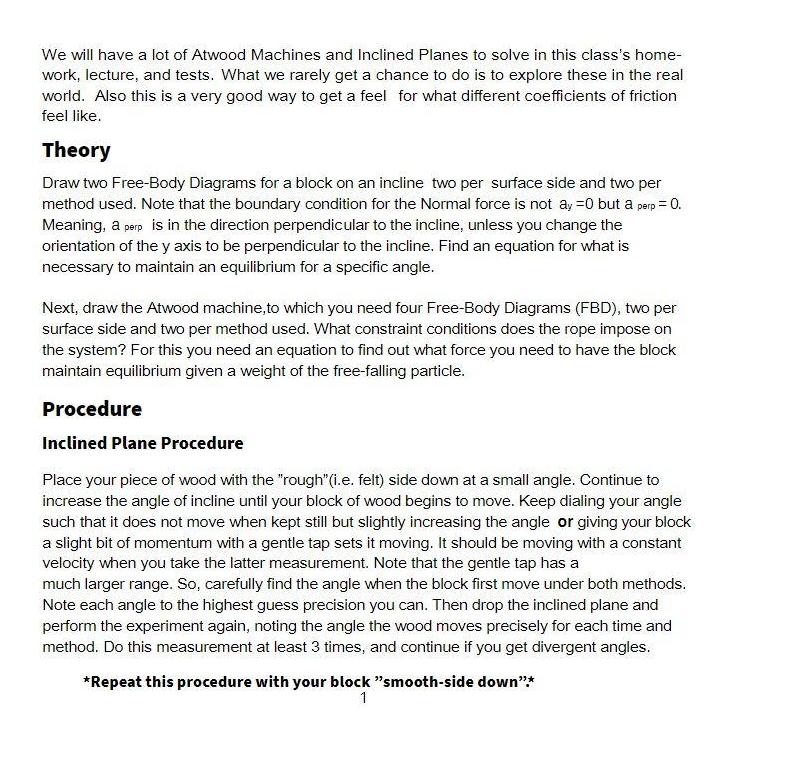Answered step by step
Verified Expert Solution
Question
1 Approved Answer
We will have a lot of Atwood Machines and Inclined Planes to solve in this class's home- work, lecture, and tests. What we rarely


We will have a lot of Atwood Machines and Inclined Planes to solve in this class's home- work, lecture, and tests. What we rarely get a chance to do is to explore these in the real world. Also this is a very good way to get a feel for what different coefficients of friction feel like. Theory Draw two Free-Body Diagrams for a block on an incline two per surface side and two per method used. Note that the boundary condition for the Normal force is not ay =0 but a perp = 0. Meaning, a perp is in the direction perpendicular to the incline, unless you change the orientation of the y axis to be perpendicular to the incline. Find an equation for what is necessary to maintain an equilibrium for a specific angle. Next, draw the Atwood machine, to which you need four Free-Body Diagrams (FBD), two per surface side and two per method used. What constraint conditions does the rope impose on the system? For this you need an equation to find out what force you need to have the block maintain equilibrium given a weight of the free-falling particle. Procedure Inclined Plane Procedure Place your piece of wood with the "rough" (i.e. felt) side down at a small angle. Continue to increase the angle of incline until your block of wood begins to move. Keep dialing your angle such that it does not move when kept still but slightly increasing the angle or giving your block a slight bit of momentum with a gentle tap sets it moving. It should be moving with a constant velocity when you take the latter measurement. Note that the gentle tap has a much larger range. So, carefully find the angle when the block first move under both methods. Note each angle to the highest guess precision you can. Then drop the inclined plane and perform the experiment again, noting the angle the wood moves precisely for each time and method. Do this measurement at least 3 times, and continue if you get divergent angles. *Repeat this procedure with your block "smooth-side down"* 1 Atwood Machine Procedure Now, place the metal track flat upon your table. Once again, start with the "rough" side of the block facing down. Next, attach a string to the loop on your wooden block to the other end to a weight carrier provided near the pulley. Be sure that the string is traveling parallel to the table's surface between your block and the pulley and make sure that your ramp is level. One person will then begin adding weights to the weight carrier while another will con- tinue to look at the wooden block and note when it begins moving. You should have 1g of precision for this measurement. Do not stop until you can change your block from "not moving" to "moving" with the addition of a single gram. Repeat this procedure, but do so by providing a gentle tap while the block is stationary until you get it moving at constant velocity. *Repeat this procedure with your block "smooth-side down"* Analysis Weigh the block of wood using the scale provided and then use your new found understanding of physics to find the two coefficients of friction between the ramp and your block's rough side ( rough). Next, do the same procedure to find the two coefficients of friction between your smooth block of wood and the ramp ( smooth). You should have four answers in total: one kinetic and one static from the inclined plane approach and one kinetic and one static from the atwood machine approach. Lab Deliverables 1) Which approach grants you greater precision? Why? Did you use any outside measure- ment approaches to gain you this added precision? 2) Do your 's agree with each other from the different approaches? If not, are the two approaches measuring different quantities? 3) Which did you expect to be larger, rough or smooth? Which turned out to be larger? 4) Make sure to include the sources of error and imprecision in your writeup. Did you de- cide to take any additional measurements other than the ones proscribed in the procedure? 2
Step by Step Solution
★★★★★
3.48 Rating (158 Votes )
There are 3 Steps involved in it
Step: 1
Solution Since coefficient ve ii iv 0 0 ...
Get Instant Access to Expert-Tailored Solutions
See step-by-step solutions with expert insights and AI powered tools for academic success
Step: 2

Step: 3

Ace Your Homework with AI
Get the answers you need in no time with our AI-driven, step-by-step assistance
Get Started


